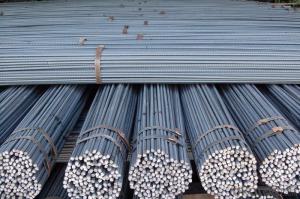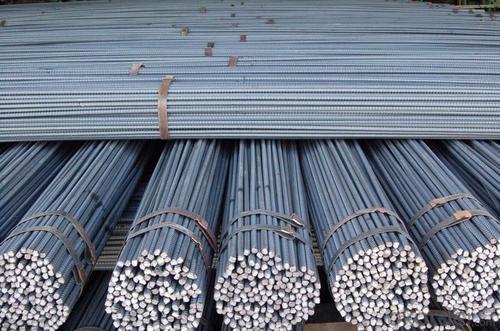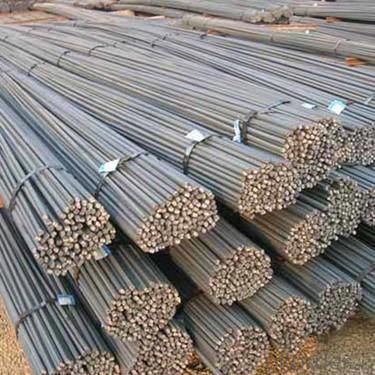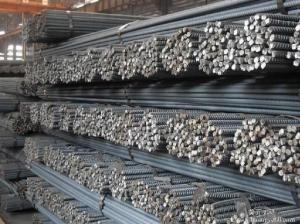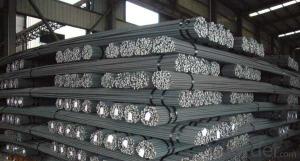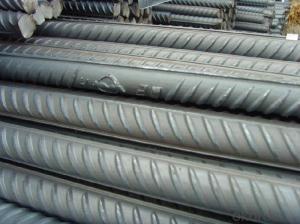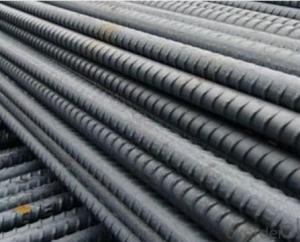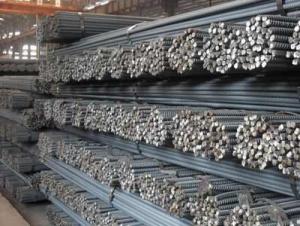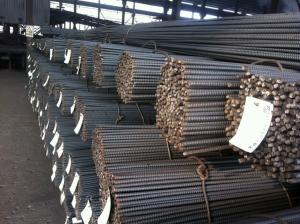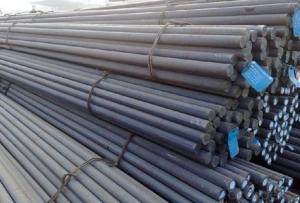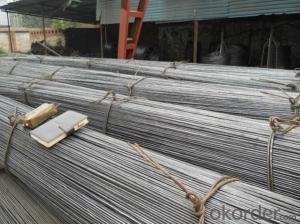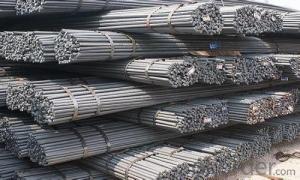BST500S deformed steel bar for construction
- Loading Port:
- Tianjin
- Payment Terms:
- TT OR LC
- Min Order Qty:
- 25 m.t.
- Supply Capability:
- 10000 m.t./month
OKorder Service Pledge
OKorder Financial Service
You Might Also Like
Product Description:
Specifications of HRB400 Deformed Steel Bar:
Standard | GB | HRB400 | |
Diameter | 6mm,8mm,10mm,12mm,14mm,16mm,18mm,20mm, 22mm,25mm,28mm,32mm,36mm,40mm,50mm | ||
Length | 6M, 9M,12M or as required | ||
Place of origin | Hebei, China mainland | ||
Advantages | exact size, regular package, chemical and mechanical properties are stable. | ||
Type | Hot rolled deformed steel bar | ||
Brand name | DRAGON | ||
Chemical Composition: (Please kindly find our chemistry of our material based on HRB500 as below for your information)
Grade | Technical data of the original chemical composition (%) | ||||||
C | Mn | Si | S | P | V | ||
HRB400 | ≤0.25 | ≤1.60 | ≤0.80 | ≤0.045 | ≤0.045 | 0.04-0.12 | |
Physical capability | |||||||
Yield Strength (N/cm²) | Tensile Strength (N/cm²) | Elongation (%) | |||||
≥400 | ≥570 | ≥14 | |||||
Theoretical weight and section area of each diameter as below for your information:
Diameter(mm) | Section area (mm²) | Mass(kg/m) | Weight of 12m bar(kg) |
6 | 28.27 | 0.222 | 2.664 |
8 | 50.27 | 0.395 | 4.74 |
10 | 78.54 | 0.617 | 7.404 |
12 | 113.1 | 0.888 | 10.656 |
14 | 153.9 | 1.21 | 14.52 |
16 | 201.1 | 1.58 | 18.96 |
18 | 254.5 | 2.00 | 24 |
20 | 314.2 | 2.47 | 29.64 |
22 | 380.1 | 2.98 | 35.76 |
25 | 490.9 | 3.85 | 46.2 |
28 | 615.8 | 4.83 | 57.96 |
32 | 804.2 | 6.31 | 75.72 |
36 | 1018 | 7.99 | 98.88 |
40 | 1257 | 9.87 | 118.44 |
50 | 1964 | 15.42 | 185.04 |
Usage and Applications of HRB400 Deformed Steel Bar:
Deformed bar is widely used in buildings, bridges, roads and other engineering construction. Big to highways, railways, bridges, culverts, tunnels, public facilities such as flood control, dam, small to housing construction, beam, column, wall and the foundation of the plate, deformed bar is an integral structure material. With the development of world economy and the vigorous development of infrastructure construction, real estate, the demand for deformed bar will be larger and larger..
Packaging & Delivery of HRB400 Deformed Steel Bar:
Packaging Detail: products are packed in bundle and then shipped by container or bulk vessel, deformed bar is usually naked strapping delivery, when storing, please pay attention to moisture proof. The performance of rust will produce adverse effect.
Each bundle weight: 2-3MT, or as required
Payment term: TT or L/C
Delivery Detail: within 45 days after received advanced payment or LC.
Label: to be specified by customer, generally, each bundle has 1-2 labels
Trade terms: FOB, CFR, CIF
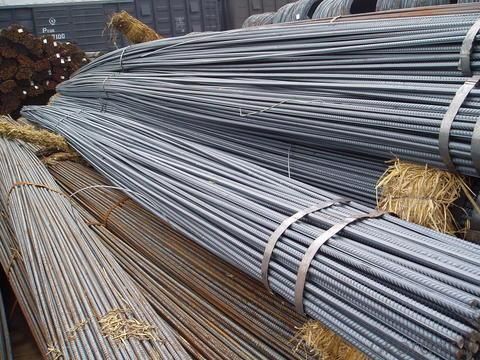
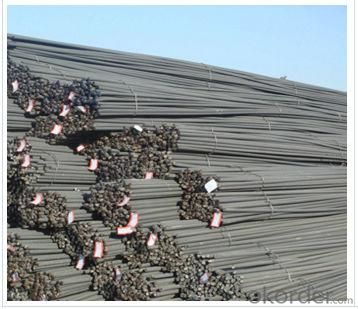
- Q: Can steel rebars be used in concrete columns?
- Yes, steel rebars can be used in concrete columns. In fact, steel rebars are commonly used as reinforcement in concrete structures, including columns. The primary purpose of using rebars in concrete columns is to enhance their strength and durability. The rebars are embedded within the concrete mixture, providing additional tensile strength to the structure. This helps to prevent cracking and failure of the columns under various loads and forces. The use of steel rebars in concrete columns is a widely accepted practice in the construction industry and is essential in ensuring the structural integrity and longevity of the columns.
- Q: How do steel rebars affect the thermal properties of a structure?
- The thermal properties of a building or structure can be significantly influenced by steel rebars, which are commonly used in reinforced concrete structures. To begin with, steel rebars have a higher thermal conductivity than concrete. This means that when embedded within concrete, they can serve as thermal bridges, allowing heat to easily transfer through the structure. Consequently, there is increased heat loss during colder months and increased heat gain during warmer months, leading to higher energy consumption for heating and cooling. Additionally, the thermal expansion and contraction of the structure can be affected by steel rebars. Compared to concrete, steel has a higher coefficient of thermal expansion, causing it to expand and contract more with temperature changes. This differential movement between the steel rebars and the surrounding concrete can result in cracks and structural deformations, compromising the overall thermal performance of the structure. Moreover, the moisture behavior of a structure can also be influenced by steel rebars. As previously mentioned, steel has a higher thermal conductivity and electrical conductivity than concrete. This electrical conductivity can promote the corrosion of steel rebars when they come into contact with moisture or water. Consequently, corrosion leads to the formation of rust, which expands and further damages the surrounding concrete. This, in turn, increases moisture ingress, compromising the insulation properties of the structure and potentially causing mold growth and other moisture-related issues. To conclude, steel rebars have direct and indirect impacts on the thermal properties of a structure. They act as thermal bridges, affecting heat transfer, and their differential thermal expansion and corrosion potential can compromise the overall thermal performance and moisture behavior of the structure. Proper design, insulation, and corrosion protection measures should be implemented to mitigate these effects and ensure optimal thermal performance.
- Q: What are the different types of coatings available for steel rebars to prevent corrosion?
- There are several types of coatings available for steel rebars to prevent corrosion. These coatings are designed to provide a protective barrier between the steel rebar and the surrounding environment, thereby preventing or minimizing the corrosion process. The different types of coatings include: 1. Epoxy Coating: This is a commonly used coating for steel rebars. It is a thermosetting polymer that forms a strong and durable protective layer. Epoxy coatings are known for their excellent resistance to chemicals and abrasion. 2. Zinc Coating: Zinc coatings, such as hot-dip galvanization, are widely used to protect steel rebars from corrosion. The zinc layer acts as a sacrificial anode, meaning it corrodes instead of the steel rebar, protecting it from oxidation. 3. Fusion-Bonded Epoxy Coating: This coating involves melting epoxy powder onto the steel rebar's surface, creating a strong bond. Fusion-bonded epoxy coatings are resistant to corrosion, chemicals, and moisture. 4. Polymer Coating: Polymer coatings, such as polyethylene or polypropylene, provide a protective layer against corrosion. These coatings are highly resistant to chemicals, abrasion, and moisture, ensuring long-term protection for the steel rebar. 5. Concrete Coating: Concrete can act as a protective coating for steel rebars when it is properly applied. The alkaline environment of concrete helps to passivate the steel rebar, forming a protective oxide layer that prevents further corrosion. 6. Stainless Steel Coating: Applying a thin layer of stainless steel onto the steel rebar's surface can significantly enhance its corrosion resistance. Stainless steel coatings offer excellent durability and resistance to harsh environments. It is important to choose the appropriate coating based on the specific application and environmental conditions to ensure optimal protection against corrosion for steel rebars.
- Q: How are steel rebars protected against corrosion in aggressive environments?
- Various methods are utilized to protect steel rebars from corrosion in aggressive environments. One commonly employed approach involves the application of protective coatings. These coatings are administered to the surface of the rebars, establishing a barrier between the steel and the corrosive elements present in the surroundings. Examples of protective coatings comprise epoxy, zinc, and polyethylene coatings. Furthermore, cathodic protection is another means of safeguarding steel rebars. This technique involves linking the rebar to a sacrificial anode, often composed of a more reactive metal like zinc or magnesium. By doing so, the anode corrodes instead of the rebar, effectively sacrificing itself to shield the steel against corrosion. Additionally, corrosion inhibitors can be utilized to protect steel rebars. These inhibitors can be incorporated into the concrete mixture or directly applied to the rebars. Their function is to diminish the corrosive potential of the environment or form a protective film on the surface of the rebar, curtailing corrosion. Moreover, proper design and construction practices can play a pivotal role in preserving the integrity of steel rebars against corrosion. Sufficient concrete cover can aid in establishing a physical barrier between the rebar and the aggressive environment, thereby minimizing the steel's exposure to corrosive elements. Additionally, effective drainage systems and the use of non-corrosive aggregates contribute to the reduction of rebars' exposure to moisture and other corrosive substances. In summary, a combination of protective coatings, cathodic protection, corrosion inhibitors, and appropriate design and construction practices are employed to guarantee the protection of steel rebars in aggressive environments. These measures effectively prolong the lifespan of structures and uphold their structural integrity.
- Q: Are steel rebars resistant to chemicals?
- Steel rebars are typically resistant to chemicals. Steel is renowned for its strength and durability, enabling it to endure exposure to various chemicals without significant deterioration. However, the level of resistance may vary based on the specific chemical, concentration, and duration of exposure. Generally, steel rebars exhibit high resistance to commonly found construction materials and environments, including water, concrete additives, and standard cleaning agents. They also withstand acids, alkalis, and organic solvents. Nevertheless, aggressive chemicals like strong acids or oxidizing agents can lead to corrosion or damage over time. Therefore, it is crucial to consider the chemical environment when choosing and utilizing steel rebars, and implement appropriate safeguards if necessary, such as protective coatings or corrosion inhibitors.
- Q: Can steel rebars be used in wastewater storage tanks?
- Yes, steel rebars can be used in wastewater storage tanks. Steel rebars are commonly used as reinforcement in concrete structures, including wastewater storage tanks. The rebars provide tensile strength to the concrete, making it more resistant to cracking and improving the overall structural integrity of the tank. Additionally, steel rebars are corrosion-resistant, which is crucial in wastewater storage tanks where exposure to corrosive elements is inevitable. Therefore, using steel rebars in wastewater storage tanks is a common and effective practice in the construction industry.
- Q: What is the purpose of using steel rebars in construction?
- The purpose of using steel rebars in construction is to provide reinforcement and strength to concrete structures. Steel rebars enhance the structural integrity of buildings, bridges, and other constructions by improving their resistance to tension forces, preventing cracks, and enhancing overall durability.
- Q: Can steel rebars be used in seawater desalination plants?
- Yes, steel rebars can be used in seawater desalination plants. However, it is important to consider the potential effects of corrosion due to the high salt content in seawater. To mitigate this risk, various measures can be taken. One common approach is to use corrosion-resistant alloys, such as stainless steel rebars or epoxy-coated rebars, to protect against the corrosive effects of saltwater. Additionally, proper maintenance and monitoring can help prevent and identify any corrosion issues. Overall, while steel rebars can be used in seawater desalination plants, it is crucial to implement corrosion protection measures to ensure their longevity and structural integrity.
- Q: How do steel rebars affect the fire resistance of a structure?
- Steel rebars can have both positive and negative effects on the fire resistance of a structure. On one hand, steel rebars can enhance the fire resistance of a structure by providing additional strength and stability. The presence of steel rebars in concrete structures can help prevent collapse during a fire, allowing more time for occupants to evacuate and emergency responders to control the situation. However, steel rebars also have some drawbacks when it comes to fire resistance. Steel is a highly conductive material, meaning it can transfer heat quickly. During a fire, the steel rebars can heat up and transfer the heat to the surrounding concrete, potentially weakening its structural integrity. This can result in a reduced fire resistance of the structure. To mitigate the negative effects of steel rebars on fire resistance, certain measures can be taken. One common approach is to apply fire-resistant coatings or wraps to the steel rebars. These coatings or wraps act as a barrier, slowing down the heat transfer from the steel to the concrete, thus enhancing the fire resistance. Additionally, the size, spacing, and arrangement of steel rebars can also impact the fire resistance of a structure. Proper design and placement of rebars can ensure that the heat is distributed more evenly, reducing the risk of localized weakening and structural failure. In summary, steel rebars can have a significant impact on the fire resistance of a structure. While they can enhance the overall strength and stability, they can also contribute to the heat transfer and potential weakening of the structure. By implementing appropriate measures such as fire-resistant coatings and proper design, the negative effects of steel rebars on fire resistance can be minimized, ensuring the safety and integrity of the structure during a fire.
- Q: How do steel rebars contribute to the overall stiffness of a structure?
- Steel rebars contribute to the overall stiffness of a structure by providing reinforcement and enhancing its load-bearing capacity. When embedded within concrete, steel rebars form a composite material known as reinforced concrete, which combines the compressive strength of concrete with the tensile strength of steel. The primary function of steel rebars is to resist tensile forces that can cause concrete to crack or fail. Concrete has excellent compressive strength but is weak in tension. By adding steel rebars, the overall stiffness of the structure is increased, as the rebars take up the tensile stresses and prevent the concrete from failing under tension. The rebars are strategically placed within the concrete to resist anticipated forces and distribute them evenly across the structure. As external loads are applied to the structure, such as the weight of the building or environmental forces like wind or earthquakes, the rebars counteract the tension caused by these loads. This reinforcement ensures that the structure remains intact and stable, preventing any major deformations or collapse. Moreover, steel rebars also contribute to the ductility of the structure. Ductility refers to the ability of a material to undergo deformation without fracturing. Steel has high ductility, and when incorporated into reinforced concrete, it allows the structure to withstand some level of flexure and movement without compromising its overall strength and stability. This improved ductility enhances the structural resilience, making the building more resistant to extreme external forces. In summary, steel rebars play a crucial role in contributing to the overall stiffness of a structure by reinforcing the concrete and providing tensile strength. They prevent cracking and failure under tension, distribute forces evenly, and increase the structural resilience and ductility. By combining the compressive strength of concrete with the tensile strength of steel, steel rebars ensure that the structure can withstand various loads and maintain its stability and integrity over time.
Send your message to us
BST500S deformed steel bar for construction
- Loading Port:
- Tianjin
- Payment Terms:
- TT OR LC
- Min Order Qty:
- 25 m.t.
- Supply Capability:
- 10000 m.t./month
OKorder Service Pledge
OKorder Financial Service
Similar products
Hot products
Hot Searches
Related keywords
